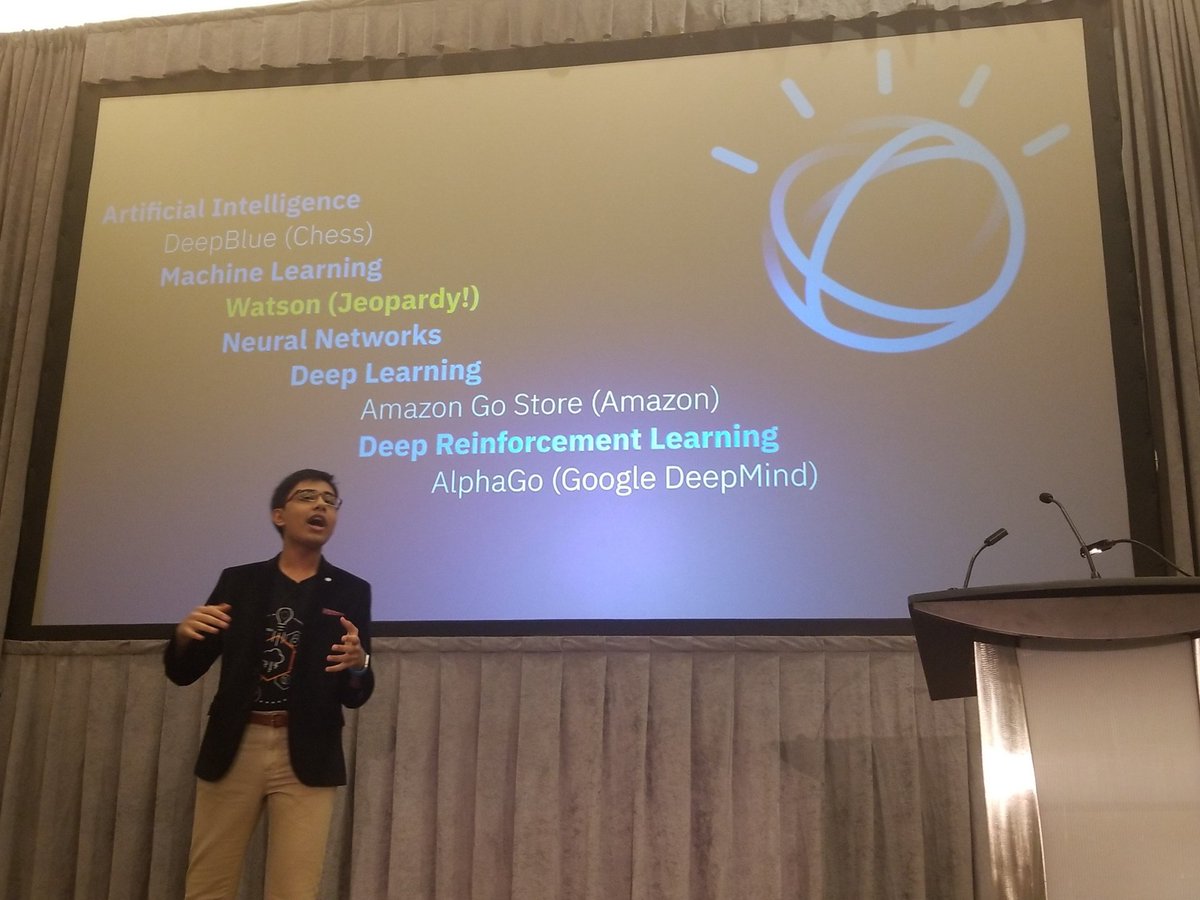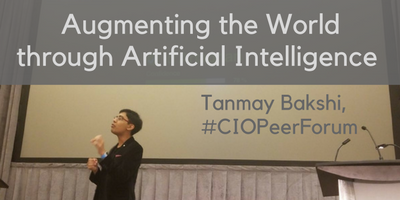By: Olga Volkoff
Worried by all the bad news you are hearing these days? No need – Tanmay Bakshi, the closing keynote speaker at the CIO Peer Forum last week, gave us all some very good reasons to be much more optimistic.
In case you don’t already know, Tanmay is the 14-year old from Ontario who started coding when he was five, and has since become an algorithmist, a book author, a YouTuber, and a cognitive and AI developer that impresses experts at IBM. Speaking at the Peer Forum is also no novelty for him. He is a TEDx speaker and has made presentations to thousands of people in conferences around the world. His passion – and boy is he passionate! – is to harness the power of neural networks and associated machine learning to solve pressing problems in our world.

His talk inspired me in so many ways. Quite apart from the content of his presentation, I was struck by his energy, passion, and positivity. He spoke articulately, knowledgeably, and without apparent notes while literally bouncing around the stage with enthusiasm for his topic. If the rest of us had half his energy we’d be able to move mountains. In the meantime, he might well be able to move them by himself. All this by itself makes me optimistic. With young people like Tanmay showing us his commitment to making change, and his clear ability to achieve remarkable outcomes, the future is in good hands.
But as impressive as Tanmay is as a person, let’s look at what he had to say – it is equally remarkable. He started by talking about artificial intelligence, comparing what a computer can do with what humans are capable of. Will machines ever be able to simulate human-like intuition? For all their sophistication, computers are essentially still only good at one thing, which is performing complicated mathematical operations at extremely high speed. That’s impressive, but still a fairly structured task. Humans, on the other hand, have sophisticated innate abilities, namely processing natural language, visual data and auditory information – all unstructured, and all at the same time. Since 80% of business data is unstructured, this gives humans an advantage. As compared to a computer, which completes tasks by utilizing its capability to review a lot of data quickly, we know how to extrapolate from a few data points by extrapolating to familiar patterns built up through a learning process that builds our neural networks through various reward mechanisms. It is in mimicking these processes – deep reinforcement learning to create machine neural networks – that we can create artificial intelligence. What Tanmay has been doing is writing the deep learning algorithms that help computers learn to recognize patterns and extrapolate to new situations.
One such algorithm he built is a “Social Media Analyzer” that allows real time analysis of customer sentiment, which would enable an organization to quickly flag unusual trends. A second project was to build something he calls Power AI Vision, which can recognize different types of visual objects. This type of deep learning algorithm requires labelled training data so that variations in such objects can be accommodated. If you consider our innate ability to recognize certain visual objects as belonging to a class – he used the example of a face – regardless of the angle at which we see them and in all the wondrous variety that the natural world presents, then you can appreciate the sophistication of what we would like our machines to be capable of.
Asking a machine to learn to handle the incredible variety of things we are good at – or, more specifically, asking an AI expert to train a machine to have that ability – is frankly unreasonable. Moreover, it is unnecessary – humans exist and can already perform those functions. The problem is that humans are slow, and to overcome our lack of speed, we take shortcuts (e.g., we fill in the blanks by seeing what we expect to see), which can introduce error. Where AI becomes particularly useful is in combining the learning a machine can realistically accomplish with its existing capabilities, namely speed and reliability in performing structured tasks without bias. This suggests focusing on specific and somewhat narrow domains that already have a lot of data collected and domain experts that can classify subsets of that data so it can be used for training our machines. In Tanmay’s view, the obvious application for AI is healthcare. This is a field where a lot of data is collected. For example, in the US, 60 billion images are collected every year. Thus, one obvious application is for machines to review images of melanoma to flag those that are problematic. In fact such systems already exist.
Tanmay’s personal passion is in the realm of mental health. He is currently working with a partner to help detect patterns that could provide an early warning system to prevent teen suicide. He has recently expanded this project to do the same for preventing veteran suicide. Going beyond initial diagnosis, they’d then like to help provide the necessary therapy. In its traditional form, therapy is interactive with naturally flowing dialogue, not predetermined dialogue structure. The challenge in this case is, as Tanmay puts it, to “AI-ify” e-therapy. Generating the necessary flexibility for the system-supported conversations will involve many individual modules addressing all possible directions a conversation could take. Given the critical shortage of and enormous need for therapists, if such a system can be built, it could address a huge need. Tanmay stresses, however, that the limits of AI should be recognized. It will not be replacing us any time soon. It is created by humans to amplify human skill and is best suited for somewhat narrow domains. Thus, rather than calling it AI, he prefers to call it IA – Intelligence Augmented.
I remind you, Tanmay, who explained all of this clearly, and demonstrated some of what he has already built to us in real time, is still only fourteen years old. Imagine what he will accomplish in the years to come. I think that is good reason for being optimistic about the future.
Retired academic. Formerly a professor of MIS and Associate Dean at the Beedie School of Business, Simon Fraser University. Taught courses in IS strategy and Systems Analysis and Design. When not singing in choirs or traveling, continues to do research on the challenges of implementing and using large-packaged software effectively.
